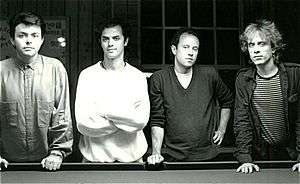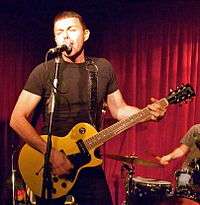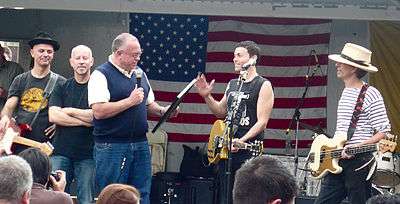The Bongos
| The Bongos | |
|---|---|
 The Bongos (Clockwise): Richard Barone, James Mastro, Rob Norris, Frank Giannini. Photographed for GQ Magazine by Edo Bertoglio. | |
| Background information | |
| Origin | Hoboken, NJ, USA |
| Genres | Power pop[1] |
| Years active | 1980–1987 |
| Labels | RCA Records, Sony BMG, Sony Legacy, Razor & Tie, Fetish Records, PVC Records, Stiff, Cooking Vinyl, Jem Records |
| Associated acts | Richard Barone, The Health & Happiness Show, East of Venus |
| Website | http://facebook.com/TheBongosOfficial |
| Members |
Richard Barone Rob Norris Frank Giannini James Mastro |
The Bongos were a power pop band from Hoboken, New Jersey, primarily active in the 1980s, led by Richard Barone. With their unique musical style, they were major progenitors of the Hoboken pop scene, college radio favorites, and made the leap to national recognition with the advent of MTV. Their breakthrough song "Numbers With Wings" garnered the group a major cult following and was nominated at the first MTV Video Music Awards. Along with a handful of others, The Bongos were instrumental in the advancement of the Alternative Rock movement.
History
The Bongos grew out of a band called, "a", which had included the three original Bongos and Glenn Morrow, who later formed The Individuals and helped found Bar/None Records. "a" was the first band to play Maxwell's, a rock and roll club in Hoboken.
The group was led by Richard Barone on vocals and guitar and included Rob Norris, formerly of the Zantees on bass and Frank Giannini on drums. James Mastro, later of The Health & Happiness Show, joined the band as a guitarist after the release of their first LP. The group played extensively in Hoboken and New York City and toured the U.K. and Europe before touring in the U.S.
The Bongos emerged from Hoboken, and Manhattan's new wave and no wave venues such as Tier 3 and the Mudd Club, with a guitar-driven pop that included a strong influence of avant-garde and propulsive dance music. One of their early excursions as a trio was backing up violinist Helen Hooke of the legendary group The Deadly Nightshade (one of the first all-woman rock bands of the 1970s) at Gerde's Folk City. Hooke was instrumental in helping the band create their first demo recording. Soon, well-reviewed shows at Hurrah, Danceteria, and later The Ritz established them as particularly effective live performers. What set them apart from other such groups of the era were their sudden guitar outbursts or saxophone improvisations that echoed the work of Lou Reed, Ornette Coleman, or Captain Beefheart within the context of a pure, melodic pop song. In addition, unlike many of their peers, the group explored unabashedly sensual dance rhythms that made their recordings dance-floor favorites.

While in London performing at The Rainbow Theatre, Dingwall's, and trendy Cabaret Futura, the Bongos recorded their early singles and their well-received debut EP Time and the River for UK-based Fetish Records. Cover designs for their Fetish releases were created by influential graphic artist Neville Brody, who was soon to become the designer of The Face magazine. The group's love of avant-garde performers brought them in touch with artists such as Throbbing Gristle and Clock DVA who performed with them live in London, and on their recordings. Their debut U.S. album, Drums Along The Hudson, compiled from the band's British singles, was released in 1982 to widely favorable reviews on both sides of the Atlantic. While Trouser Press suggested that the group "may trade a certain amount of substance for easy appeal," it added that "there's no better musical equivalent of whipped cream anywhere."[2] Writing in the Village Voice, Robert Christgau dryly commented that "for all their jumpy originality [the songs are] still slight, and Richard Barone's lyrics are so oblique you have to wonder what his angle is."[3] In 2007 however, Jim DeRegotis wrote in the Chicago Sun-Times: "The initial impression of naiveté is offset by deceptively simple lyrics that actually hint at deep, dark mysteries and unfathomed mystical enigmas."[4] The group's cover of T. Rex's "Mambo Sun" reached No. 22 on the Billboard Dance Chart. A thriving Hoboken pop scene emerged, triggered by the Bongos and Maxwell's, which gained national media attention, and drew many bands and fans to the city. An August 1, 1982 article in the New York Times Real Estate section hinted at the scene's popularity as an influence on increasing rents and property values.[5]
In 1983, the group was signed to RCA Records, which subsequently released the album, Numbers With Wings. New York Times' critic Robert Palmer — himself a former Hoboken-based musician with The Insect Trust — marked this as the beginning of the Bongos' creative decline, lamenting the "slick, overproduced records which vitiated the raw vitality the group had originally displayed."[6] Regardless, the album spawned a popular and inventive MTV video of the title song (nominated for 'Best Direction' on the 1984 MTV Video Music Awards, and the song itself remained at the number one spot on the College Music Journal (CMJ) chart for six consecutive weeks. The album also included the tribal, dance-floor hit "Barbarella." A hectic tour schedule of over 300 shows a year sustained support at radio and MTV. Their Brazilian-influenced follow-up album, Beat Hotel, along with relentless touring, now with a further-expanded lineup including percussionist Steve Scales from Talking Heads, raised the Bongos' profile further and continued to increase their devoted cult following. It was in the midst of recording the Phantom Train album in Compass Point, Bahamas for Island Records that the band split up in 1987, with each member pursuing solo interests. The album was to remain unfinished and unreleased until 2013.
Recent work
Richard Barone has subsequently released a series of well-received solo albums, including Glow released on September 14, 2010 on Hoboken's Bar/None Records, a 3-disc CD/DVD live collection 'cool blue halo' 25th Anniversary Concert on the DigSin label in 2012, and Sorrows & Promises: Greenwich Village in the 1960s in late 2016. He tours regularly and has also established a career as a recording and concert producer. Since 2011, Barone has been a professor at NYU's Clive Davis Institute of Recorded Music and more recently at The New School of Jazz and Contemporary Music. He serves on the Board of Governors for the Recording Academy/Grammys and on the advisory board of Anthology Film Archives. His memoir Frontman was published by Hal Leonard Books. James Mastro owns a popular guitar shop in Hoboken ("The Guitar Bar") and tours regularly as guitarist for Ian Hunter and for the reformed Mott the Hoople. Bassist Rob Norris plays in numerous groups including some offshoots of The Feelies, while drummer Frank Giannini pursues other interests and continues drumming on various projects.

In 2006, the original three Bongos re-entered the studio with longtime fan Moby producing to create bonus material for a CD reissue of the group's debut album. The remastered, 27-track special edition of Drums Along The Hudson, which was released internationally by Cooking Vinyl Records in June, 2007, includes rare, live bonus tracks and new studio recordings. An accompanying video for "Bulrushes 2007," a remake of the band's early single "The Bulrushes" featuring Moby seen mixing the track, was released simultaneously on iTunes.
The original three Bongos also reunited for two shows at Joe's Pub at The Public Theater in Greenwich Village in October 2006, and two more in February 2007. On September 30, 2007, the foursome played again in Hoboken for the first time in twenty years to an overflowing and appreciative crowd, and received a Proclamation from Mayor David Roberts commending them for their substantial contributions to Hoboken's culture and heritage. They headlined a day-long bill that featured the Chris Stamey Group, Glenn Mercer (formerly of the Feelies) and The Health and Happiness Show.

Richard Barone's memoir, Frontman: Surviving the Rock Star Myth, was published on September 28, 2007 by Backbeat/Hal Leonard Books.[7]
In Spring, 2008, Sony/Legacy re-issued the Bongos RCA catalog for the first time to iTunes and all digital retailers.
On March 11, 2009, the Bongos performed a full concert set at The City Winery in NYC following an R.E.M. tribute concert held earlier that evening at Carnegie Hall to benefit music education programs. On October 22, 2009 the group returned to their home club Maxwell's for the first time since 1986, and subsequently performed at Manhattan's Hiro Ballroom, during the CMJ Music Marathon 2009 that same month (with longtime friends The Fleshtones). On January 25, 2010, The Bongos reunited once again at the City Winery, this time to benefit Emergency Earthquake Relief efforts in Haiti. Various members have joined Richard Barone onstage for his solo performances.
Coming full-circle, the Bongos came together again on July 31, 2013 to perform the final concert at Maxwell's, which was closing after its long run. The original members had also performed the venue's first show. With a crowd spilling into the Hoboken streets, Barone announced that the group's "lost" album Phantom Train would finally be released on October 1, 2013. The group also promised a series of reunion shows to celebrate its release.. Marty Scott, co-founder of Jem Records announced that Phantom Train would be the first release of the reconstituted label. The album was remixed and prepared for release in summer, 2013 by Richard Barone and Steve Addabbo.[8]
On June 8, 2015 The Bongos once again came together, this time with drummer Dennis Diken of The Smithereens, to perform and act as "house band" at public radio station WFUV's "Fare Thee Well" concert for beloved radio legend Vin Scelsa at City Winery, who was retiring from radio. Besides renditions of their own songs, the group backed David Johansen, Marshall Crenshaw, Southside Johnny, Stephen Trask (composer of Hedwig and the Angry Inch), David Bromberg, and others in a three-hour concert that was broadcast on the station on July 4, 2015.
A group embarked on a mini-tour of the Northeast during October 2016 that paired them with West Coast power-pop band The Rubinoos.
Discography
Singles
- "Telephoto Lens" b/w "Glow in the Dark" (1980, Fetish Records)
- "In the Congo" b/w "Mambo Sun" (1980, Fetish Records)
- "The Bulrushes" b/w "Automatic Doors" (1981, Fetish Records)
- "Zebra Club" b/w "Certain Harbours" (1982, Fetish Records)
- "Mambo Sun" b/w "Hunting" (1982, Fetish Records)
- "Numbers with Wings" b/w "Skydiving" (1983, RCA Records)
- "Numbers with Wings" (Remix) b/w "Barbarella" (Remix) - 12" single - (1983, RCA Records)
- "Brave New World (True Love Is Ordinary)" b/w "Totem Pole" (1985, RCA Records)
- "Brave New World (True Love Is Ordinary)" (Radio Edit) - 12" single - (1985, RCA Records)
- "My Wildest Dreams" (2013, JEM Records, Digital Only)
EPs
- Time and the River (1982, Fetish Records) - Produced by Ken Thomas and The Bongos
- Numbers With Wings EP (1983, RCA Records) - Produced by Richard Gottehrer
LPs
- Beat Hotel (1985, RCA Records) - Produced by John Jansen
- Phantom Train (2013, Jem Records) - Produced by Eric (E.T.) Thorngren, The Bongos, Chris Blackwell
Compilation albums
- Drums Along the Hudson (1982, PVC Records - the album features the first singles and the first e.p.) - Co-produced by Ken Thomas, Mark Abel
- Start Swimming (1981, Stiff Records) ("Telephoto Lens" and "In the Congo" appear on this live recording from London's Rainbow theatre. The band, then still a trio, was joined on "In the Congo" by members of Bush Tetras and Throbbing Gristle.)
- "Numbers With Wings" and other songs appear on numerous 80s compilations on a variety of labels.
- Drums Along the Hudson – Special Edition (2007, Cooking Vinyl; 2014, Jem Records)
Videos
- In The Congo - Directed by Ed Steinberg
- Mambo Sun - Directed by Ed Steinberg
- The Bulrushes - Directed by Phil Marino
- Numbers With Wings - Directed by Juliano Waldmann
- Brave New World - Directed by Juliano Waldmann
- Bulrushes 2007 (with Moby) - Directed by Richard Kerris
- The Nomi Song - Directed by Andrew Horn
References
- ↑ Hermes, Will (October 2007). "Reissues: The best finds of the month". Spin. 23 (10): 96. ISSN 0886-3032.
- ↑ Trouserpress.com
- ↑ Robertchristgau.com
- ↑ Suntimes.com
- ↑ Nytimes.com
- ↑ Nytimes.com
- ↑ Frontmanbook.com Archived 2008-04-01 at the Wayback Machine.
- ↑ Rob Ross, Flash: Marty Scott resurrects Jem Recordings; Legendary lost album from The Bongos to be label's first release. Popdose, July 10, 2013. Retrieved 2013-08-24.